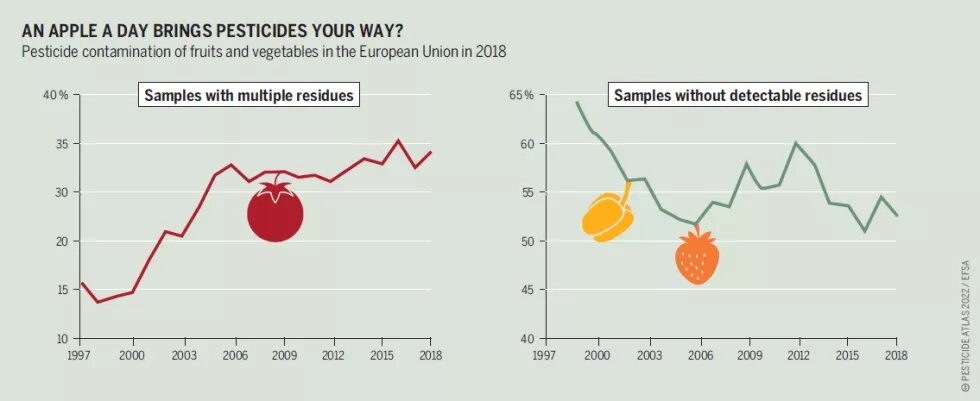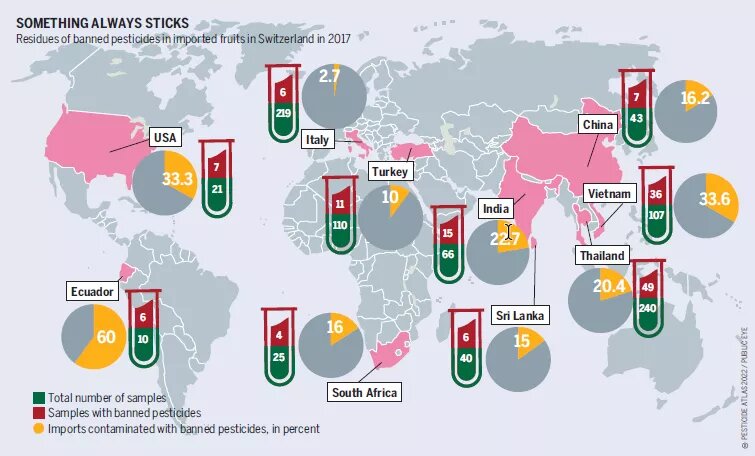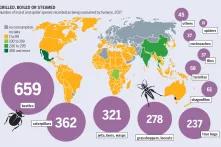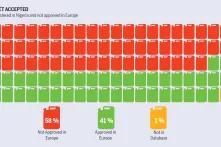

Chemical residues can be problematic to animals and humans. The daily intake of pesticide-contaminated food can pose severe health risks. Sensitive groups such as pregnant women or children are particularly at risk. To protect consumers from pesticide residues in food, governments are usually mandated to take regulatory action for public health protection. Legislation generally provides for the limitation of residue levels that may be allowed in food items entering or leaving various countries. These maximum residue levels (MRLs) are set by authorized regulatory agencies almost everywhere in the world. Since 1963, the United Nations published the Codex Alimentarius - a collection of standards for food safety and product quality. The maximum residue levels contained therein are considered an important international reference. Nonetheless, there are big differences in the maximum legal intake quantity of pesticide residues depending on the country and region.
For each approved active ingredient, the European Union specifies the maximum concentration of residues to be legally permitted in various food. If goods exceed the limits, they may not be placed on the market. Kenya’s regulatory authority, the Pest Control Products Board (PCPB), in most cases, adopts the same MRLs that are used in Europe or the USA, where standards are less strict. This is worrying because local diets are different in Kenya. Maize, a staple food is consumed in greater quantities in Kenya than it is in Europe and should therefore have stricter limits for pesticide residues. Legislation should be strengthened through a local human health risk assessment taking into account the Kenyan dietary intake and consumption patterns.
Maximum residue levels are based on the cultivation practices, the toxicity of the active ingredient, and food consumption. Baby food must meet stricter specifications. In 2018, under the requirements of the USAID FOODSCAP Project, 1,139 samples of fresh produce intended for export and local markets, were tested by Kenya Plant Health Inspectorate Service (KEPHIS). Pesticides were detected on 46 percent of the samples while 11 percent had residues exceeding EU maximum residue levels. The food items with the highest residues were kales, peas, and capsicum.
Health experts criticize the absence of maximum legal limits for multiple residues in food. A further criticism is that manufacturing companies can circumvent regulations. For example, if active ingredients are at risk of losing their EU approval for health reasons such as being classified as carcinogenic, their maximum residue level for food consumed in the EU is automatically lowered to protect human health. Usually, the limit is lowered to 0.01 milligrams per kilogram, which also applies for imported goods. Pesticide manufacturers who fear a ban of one of their active ingredients for health reasons often just let EU permits expire. This way, they can apply for “import tolerance”: A higher MRL set for imported products to meet the needs of international trade. EU law forbids granting this for pesticides that have lost their approval because of health effects.
The EU has a tighter regulation than many non-EU countries. In Japan, for example, almonds may be contaminated with one milligram glyphosate per kilogram – which is ten times as much as the EU permits. In the Eastern Mediterranean, an area that is home to nearly 680 million people and includes countries from the Middle East to Central Asia, maximum residue levels have been exceeded in up to 61 percent of food samples over the past 15 years. Repeatedly, residues of pesticides that have been banned for a long time are detected there.
Brazil is another example for a lack of efficient regulation that imposes on its population maximum residue levels in food that are two or three times higher than the maximum residue levels in the EU. In 2019, 23 percent of all samples exceeded already high national maximum residue levels according to the official Brazilian residue report. EU banned active ingredients have also been detected as residues in Brazilian cereals, fruits and vegetables. As export goods, these pesticide residues end up again in Europe or other regions. Put differently: A pesticide which is forbidden in Europe can be exported to a third country, used on crops, and then imported back as a residue on fresh produce.
In Kenya in 2020, a total of 25 different active ingredients were found in tomato and kale samples – 51 percent of the detected active ingredients were already withdrawn from circulation in the EU long ago. Of the total of 25 samples, 60 percent exceeded the EU maximum residue levels. It is alarming in particular, because these two vegetables are often bought from local markets in rural areas and in the city and are used in many Kenyan dishes. However, there is limited information on the actual health risks associated with consumption of such commonly consumed foods.
The increase in pesticide use requires necessary safeguards to control how they are used. Independent, scientific evidence should inform policy decisions and regulation and there should be stronger political efforts to restrict or remove the most toxic pesticides – especially in Kenya and other developing contexts. Nationwide training on the proper use of pesticides is one part of any risk mitigation strategy. However, increasing knowledge and the implementation of integrated pest management approaches – where toxic pesticides are used as a last resort – as well as strong support for non-chemical plant protection, is necessary to reduce pesticide residues in food and enhance food safety.


